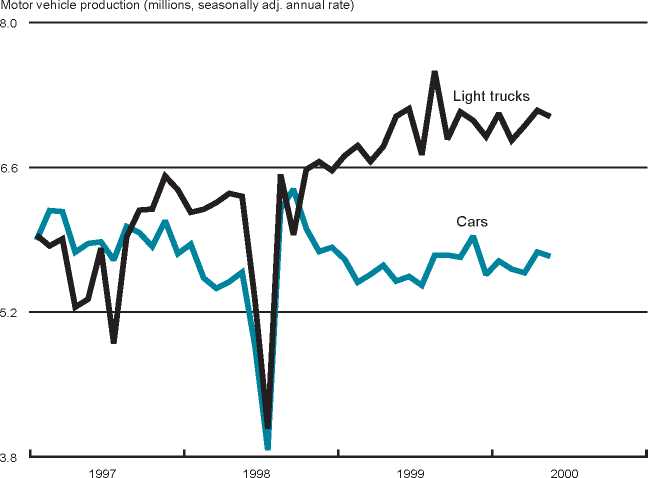Tracking Midwest manufacturing activity
Manufacturing output indexes
(1992=100)
April Month ago Year ago
CFMMI 163.9 163.2 152.3
IP 149.5 148.3 140.2
Motor vehicle production
(millions, seasonally adj. annual rate)
June Month ago Year ago
Cars 5.7 5.8 5.5
Light trucks 7.1 7.2 7.1
Purchasing managers’ surveys:
net % reporting production growth
May Month ago Year ago
MW 55.2 59.3 60.9
U.S. 56.3 58.2 58.7

Light truck production decreased slightly from 7.2 million units in May to 7.1
million units in June. Car production remained constant at 5.8 million units
in May and 5.7 million units in June.
The Chicago Fed Midwest Manufacturing Index (CFMMI) rose 0.4% from
March to April, reaching a seasonally adjusted level of 163.9 (1992=100). Revised
data show the index was at 163.2 in March, and had risen 1.1% from February.
In comparison, the Federal Reserve Board’s Industrial Production Index for
manufacturing (IP) increased 0.8% in April, after rising 0.9% in March. The
Midwest purchasing managers’ composite index (a weighted average of the
Chicago, Detroit, and Milwaukee surveys) for production decreased to 55.2%
in May from 59.3% in April. The purchasing managers’ index decreased in
Chicago and Milwaukee, but increased slightly in Detroit.
Sources: The Chicago Fed Midwest Manufactur-
ing Index (CFMMI) is a composite index of 16
industries, based on monthly hours worked and
kilowatt hours. IP represents the Federal Reserve
Board’s Industrial Production Index for the U.S.
manufacturing sector. Autos and light trucks are
measured in annualized units, using seasonal ad-
justments developed by the Board. The purchas-
ing managers’ survey data for the Midwest are
weighted averages of the seasonally adjusted pro-
duction components from the Chicago, Detroit,
and Milwaukee Purchasing Managers’ Association
surveys, with assistance from Kingsbury Interna-
tional, LTD., Comerica, and the University of
Wisconsin-Milwaukee.
31z6L HIΛIH3d
"II 'OOVOIHO
αιvd 30vιsod s∩
HVIAI SSV-IO ISdI=I
a3iaos3dd
pəisənbəj əɔɪʌjəs iumə^ɪ
TTIS-SSS (SIS)
tS80-06909 s!<lll!III ∙o⅛
t£8 x°a Od
jəiuəɔ UOpEUIJOJUJ OTjqnj
oov□ih□ ioςnvs aʌaasaa TVnaaai
.I□U□rJ pɔj (λoE□Up )
More intriguing information
1. The name is absent2. Bird’s Eye View to Indonesian Mass Conflict Revisiting the Fact of Self-Organized Criticality
3. Exchange Rate Uncertainty and Trade Growth - A Comparison of Linear and Nonlinear (Forecasting) Models
4. The name is absent
5. Smith and Rawls Share a Room
6. WP 48 - Population ageing in the Netherlands: Demographic and financial arguments for a balanced approach
7. The name is absent
8. THE UNCERTAIN FUTURE OF THE MEXICAN MARKET FOR U.S. COTTON: IMPACT OF THE ELIMINATION OF TEXTILE AND CLOTHING QUOTAS
9. The name is absent
10. The name is absent